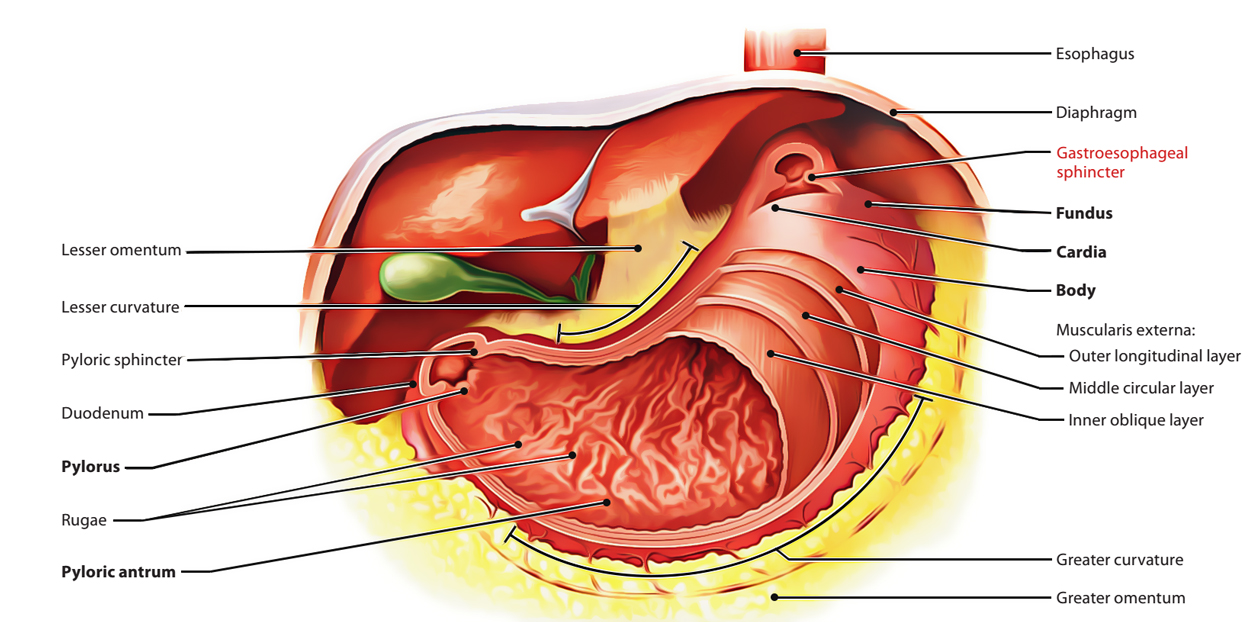Sphincters protect the esophagus at both terminations. The upper esophageal sphincter is the pharyngoesophageal sphincter, and the lower esophageal sphincter is the gastroesophageal sphincter.
A sphincter is a ring-like muscular structure that, whenever closed, stops the passage via the tube that it is protecting. The lower portion of the esophagus on the junction of the esophagus along with the stomach is covered by the lower esophageal sphincter or gastroesophageal sphincter. It is also referred to as the cardiac sphincter or cardioesophageal sphincter, named from the surrounding portion of the stomach, the cardia.
Dysfunction of the gastroesophageal sphincter results in gastroesophageal reflux, which leads to heartburn and, if it occurs commonly enough, can cause gastroesophageal reflux disease, along with damage of the esophageal mucosa.

Lower Esophageal Sphincter
Structure
The lower esophageal sphincter (LES) is a package of muscles at the low end of the esophagus, where it connects with the stomach. When the LES is closed, it stops acid and stomach contents from going back from the stomach. The LES muscles are not within voluntary control.
Function
Helps in Swallowing/Peristalisis
Loosening of the circular layer of muscle on the lower end of esophagus takes place in front of the peristaltic wave inside the stomach as the food goes down from the esophagus. This ensures that the food is not obstructed in the lower portion of esophagus and goes into the stomach.
As soon as the food has actually moved towards the stomach, the tonic constriction of this sphincter stops the materials inside the stomach from expelling into the esophagus.
Inhibition of Gastroesophageal reflux
The gastroesophageal sphincter stops reflux of gastric contents. Other than at the time of swallowing, the gastroesophageal sphincter remains compressed to keep a barricade in between the stomach and the esophagus, minimizing the possibility of reflux of acidic gastric contents back into the esophagus.
If gastric contents do stream backwards in spite of the sphincter, the level of acidity of these contents aggravates the esophagus, triggering the esophageal pain referred to as heartburn. But it does not include the heart itself. As the peristaltic wave sweeps down the esophagus, the gastroesophageal sphincter relaxes so that the bolus can enter the stomach. After the bolus has actually gotten in the stomach, the swallowing is complete and this lower esophageal sphincter once again contracts.
Nerve Supply
The closure of the gastroesophageal sphincter is under vagal control. And it is appropriate to state that this sphincter is managed by the parasympathetic nervous system due to the fact that the vagus nerve consists of just the parasympathetic fibers. The closure can be enhanced by the hormonal agent gastrin and prevented by hormonal agent secretin. Cholecystokinin and glucagon have a repressive impact on the closure of the gastroesophageal sphincter.
Clinical Significance
Gastroesophageal Reflux Disease
Gastroesophageal reflux disease (GERD) is a chronic digestive disease. GERD takes place when stomach acid or, sometimes, stomach material, recedes into one’s food pipe (esophagus). The backwash (reflux) aggravates the lining of one’s esophagus and triggers GERD.
Causes
- The primary reason for GERD is the relaxation of the gastroesophageal sphincter, which allows the stomach contents or chyme to move from the stomach back into the esophagus.
- Both acid reflux and heartburn are general digestive conditions that many individuals experience from time to time.
- One might be diagnosed with GERD when these symptoms and signs take place a minimum of two times every week or when one’s doctor can see damage to one’s esophagus.
- Repetitive direct exposure to the acidic gastric juice can cause the fragile lining of the esophagus to become inflamed.
Recovery
The majority of people can handle the pain of GERD with diet and lifestyle modifications and non-prescription medications. However, some individuals with GERD might require more powerful medications, or perhaps surgery, to minimize symptoms.

 (49 votes, average: 4.78 out of 5)
(49 votes, average: 4.78 out of 5)